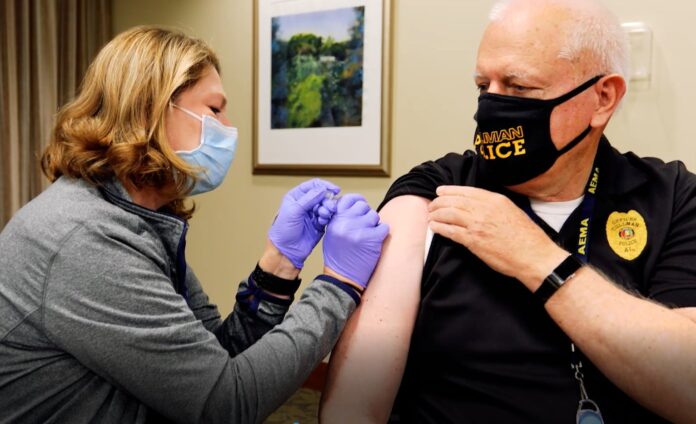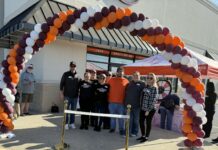
CULLMAN, Ala. – Frontline health care workers and nursing home residents were among the first group (Phase 1a) eligible to receive the COVID-19 vaccine. Parts of the next group (Phase 1b), including law enforcement, first responders and people older than 75 were next. On Monday, the Alabama Department of Public Health (ADPH) opened up all of Phase 1b and a portion of Phase 1c of is Vaccine Allocation Plan to include people older than 65, educators, people living in congregate settings, food and agriculture workers, U.S. Postal Service, manufacturing, grocery store, and public transit workers, judiciary, clergy/ministers, state legislators, supreme court and appellate judges, constitutional officers, and cabinet agency heads.
The Tribune spoke to three local people who have already received both doses about their decision to receive the vaccine and their reactions.
Brandi Lowe is an occupational therapist with Alabama Homecare of Cullman.
“I was excited to get the vaccine. I am so over it and ready to get back to normal,” she said. “Apparently, our state is lagging behind everybody else and I just wanted to do something to get us back on track.”
Lowe works with mostly older adults, describing the beginning of the pandemic as “scary.”
She added, “When it first hit, we wore PPE all the time and had to follow specific protocols. We still follow specific protocols; they are just not quite as ‘in your face’ about it. We have done it so long, it’s just second nature now instead of everything changing every few hours.”
Lowe said she knows firsthand about COVID-19, as her husband Michael tested positive in mid-September. She and their young son also had symptoms and were considered positive due to her husband testing positive.
“I watched him go from being able to work at Wal-Mart Distribution and lift 150-200-pound objects to not being able to walk from our couch to the bathroom and back for a week and a half,” she recalled. “He was only 34 (at the time), so I can’t imagine how that would affect someone in their 80s.”
Lowe said both continue to struggle with the lingering effects of the illness. She was eager to receive the vaccine.
“When I got it, I didn’t even feel it,” she said of the first shot. “It was so quick, over with and no problem. I got a little tingly in my fingers after about 30 seconds. Later that afternoon, my arm was really sore. I actually couldn’t raise it all the way up without it hurting. By the next day, there was a little soreness like with a flu or tetanus shot. By day three, it was completely back to normal.”
Lowe said she experienced similar effects after the second dose. Her arm was sore that night, and she was achy by the second day, but, again, back to normal by day three.
She added, “When I had COVID, I had heart pain, decreased endurance and brain fog. That was my biggest thing; I couldn’t concentrate, and I couldn’t’ think. I would forget what I was doing five seconds into doing it. That is just now starting to clear up and it’s been four and a half months.”
She said the side effects from the vaccine paled in comparison to the battle the Lowes faced when they had COVID-19.
Although Lowe has received both doses of the vaccine, she and her co-workers continue to follow protocols and use PPE.
“You can still get it then, therefore you can still spread it. The vaccine is basically to keep you from getting a severe case of it,” she said.
Cullman Police Chief Kenny Culpepper described himself as “thankful” that he was able to receive both doses of the vaccine. Besides the protection that comes with it, Culpepper added, “I wanted to set a good example so that people wouldn’t be afraid.”
The chief said his arm was also sore after the first dose
“I’m a side sleeper and I would roll over and it would wake me up,” he said, adding that after about 24 hours, the soreness was almost gone.
The second dose was easier for Culpepper, who said, “(It was) just a little sore just like it would be with a flu shot.”
Culpepper said he did not mandate that his officers receive the vaccine, but he did encourage them to take it. He estimated that 75-80% of his officers have been vaccinated but said there was some hesitation within the Cullman Police Department and some who opted to not to get the vaccine, “probably because of all the myths and rumors and stuff like that.” Some officers, he said, changed their minds and got it after seeing others get the vaccine.
Although most at the CPD have now received both doses of the COVID-19 vaccine, the chief said employees will continue to wear the recommended PPE.
“Even though we’ve had the vaccine, we want to set a good example for the public and encourage people to wear their masks and social distance and do what they need to do,” said Culpepper. “Now, number two, there’s a medical reason for it because of the new strains and variants that are circulating around.”
He continued, “I am very pro-vaccine. If everyone would get the vaccine as quickly as possible, then we could keep the levels down and keep it from mutating as much to where it’s going to be a threat to those who have already had the vaccine or already had COVID because their immunity may not apply. If we can do it quick enough and get enough people vaccinated, then hopefully we can stop that from happening. If nothing else, cut the hospitalization and deaths; that’s the big thing. And try to get back to normal.”
Culpepper recalled receiving the polio vaccine as a child and many vaccines during his military career as he traveled to Central and South America. “Seeing people who had some of those diseases makes you appreciate that we have the medical ability to counteract them,” he said. “To me, it’s a no brainer to take the vaccine.”
Maurice Reynolds, assistant chief at the Bethsaida Volunteer Fire Department and EMS captain at the Logan Volunteer Fire Department, said he knew he wanted the vaccine.
“Because of running medical calls, you are exposed to a lot of this virus,” he said. “There was a high volume of COVID symptom calls, so my thought was, ‘Hey, this can only help me from getting it myself.’”
Reynolds said Cullman EMS takes the majority of COVID calls, but there are times when volunteer emergency medical personnel work calls attending to COVID patients.
“Back in the summer, I took the EMT class that Vinemont put on and had several rotations I had to do with the ambulance service for my classes,” he said. “We transported several COVID patients during my clinicals, and knock on wood, with our PPE, gowns, gloves, safety glasses and masks, I guess I am one of the lucky ones who never contracted it.”
Reynolds said he was not nervous about getting the vaccine after researching it and learning more about the technology used to develop it. Like Lowe and Culpepper, he had a bit of a sore arm after the first dose and the same with the second. One of his colleagues received the vaccine at the same time, and Reynolds said his colleague had soreness that he described as “more severe” as well as a “blah feeling.” After a day or two, he said, everything was normal.
He laughed about the conspiracy theories going around about the vaccines.
“I’ve heard all of that like, ‘Oh, there’s a microchip in there.’ I tell them that if you have an iPhone or Android phone, you’ve got a microchip hanging on your hip all day long,” he smiled.
Reynolds said he also knows some people are concerned about how quickly the vaccines were developed, saying, “Yes, normally it might take 10-12 years to develop a vaccine, but people aren’t aware that the government dedicated the resources and money to the pharmaceutical companies so they can focus solely on research and development.”
Back in December, local physician and pulmonologist Dr. Scott Warner told The Tribune, “Some people are a little hesitant because it came out so quickly. Well, that’s because the government invested millions and probably billions of dollars in allowing these companies to go ahead and manufacture and stock it, even before it was approved. Because the science was so trustworthy and the need was so great, they went ahead and invested in the process ahead of time, where a company (itself) could not have taken that financial risk. If it didn’t get approved, we’d be a year from now before we had a vaccine if it went through the normal process…”
Warner said mRNA vaccine technology, which is used in both the Pfizer and Moderna products, is something that has been studied for years.
“…the technology is not new; it just hasn’t been needed for a public vaccine yet. And the methodology, which was so safe and made such good science, the government said we’ll go ahead and buy into this for this one and get six or seven others in the pipeline. Some of those are with the ‘old’ methods, which are slower: killing a virus and then putting it into a vaccine, that takes a lot longer to do to make sure it’s safe,” said Warner at the time.
Reynolds acknowledged that the vaccine could come with some side effects but added, “In my opinion, it’s like the flu vaccine. It’s insurance against contracting the virus. Insurance is the best policy, and if it can help any, it’s worth doing. The success rate of (not) contracting the virus, the studies are showing in the upper 90 percentile. To me, that shows a good rate and tells me there is nothing concerning.”
Reynolds said he also knows that he could still spread the virus even though he has been vaccinated.
“Standard hygiene practices and masks do protect the entire community,” he said. “The social distancing part is also a big part. I think the concern now is just getting enough vaccines.”
To view the Alabama COVID-19 Vaccination Allocation Plan, visit www.alabamapublichealth.gov/covid19vaccine/assets/adph-covid19-vaccination-allocation-plan.pdf.
Copyright 2021 Humble Roots, LLC. All Rights Reserved.






















